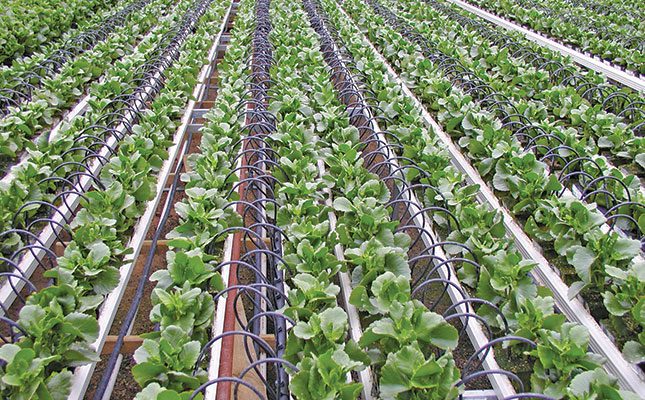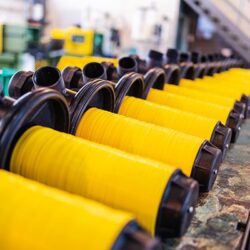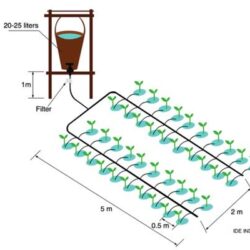Irrigation technology is expanding rapidly, as computer learning and remote monitoring become more advanced. The technology aims to improve yields, while lowering production costs and minimising the environmental impact of production. Some of the technologies are discussed below.
Drip irrigation
This technology, developed in Israel around 1959, enables a precise amount of water and nutrients to be delivered directly to the plant, reducing water waste and improving crop yield.
A recent development is the use of sensors and artificial intelligence (AI) to optimise water delivery. Netafim, for example, a leader in drip irrigation technology, offers solutions that use soil moisture sensors and weather data to automatically adjust water delivery based on crop needs, soil conditions, and weather patterns.
Micro-irrigation technology is another advance in drip irrigation. This involves the use of very small emitters that deliver water directly to the root zone of plants. Companies such as Jain Irrigation Systems offer micro-irrigation solutions specifically designed for high-value crops such as fruits, vegetables, and flowers.
Another company specialising in drip irrigation is Rivulis Irrigation, which has developed products that use recycled materials and minimise the amount of water needed for irrigation. The company’s Eco-Drip system is made from recycled plastic and delivers water to crops at a rate of only around 2ℓ/hour.
Smart irrigation
‘Smart irrigation’ is an umbrella term, but generally refers to the use of sensors and weather data to determine when and how much to water crops. As with drip irrigation, the aim of this technology is to limit water waste.
Taranis in Israeli offers a smart irrigation system that uses aerial imagery and AI to detect water stress in crops. This data is then analysed to provide farmers with customised irrigation plans.
Another Israeli company, CropX, offers a smart irrigation system that uses soil moisture sensors and data analytics to optimise irrigation scheduling. The system provides real-time data on soil moisture levels, allowing farmers to adjust water delivery based on crop needs and weather conditions.
Fieldin, a California-based company, offers farmers a smart irrigation system that integrates with existing irrigation infrastructure. The system uses sensors and data analytics to monitor water usage and detect leaks.
As technology advances, soil monitoring sensors are becoming more sophisticated. The Toro Company, a US-based manufacturer of irrigation products, offers a smart irrigation system called the Precision Soil Sensor. These wireless sensors measure soil moisture levels and transmit the information to an irrigation controller, which adjusts water delivery automatically based on the crop’s needs.
Subsurface drip irrigation
Also known as subsurface drip irrigation (SDI), this is a type of low-volume irrigation system where water is delivered to the root zone by buried dripline or drip tape. Recent developments in SDI technology focus on improving efficiency, minimising water loss, and increasing yields. Some advancements in SDI technology include:
Precision irrigation: Netafim offers advanced SDI systems that use precision irrigation technology to deliver the exact amount of water and nutrients needed by crops, based on real-time data.
Smart irrigation systems: Companies such as The Toro Company and Rain Bird provide SDI systems with smart irrigation controllers that use weather data, soil moisture sensors, and flow meters to optimise water usage.
Use of recycled water: Jain Irrigation Systems offer SDI systems that use recycled or reclaimed water in order to conserve resources and reduce the environmental impact of irrigation.
Drip tape technology: Rivulis and Toro offer SDI systems that use advanced drip tape technology to improve efficiency and reduce water loss.
Overall, these developments in SDI technology aim to make irrigation more efficient, sustainable, and cost-effective, while also improving crop yields.
Soil moisture sensors
These sensors monitor soil moisture levels and provide data that can help farmers optimise their irrigation schedule, preventing over- and underwatering. Soil sensor technology has made significant advancements in recent years, enabling farmers to better monitor soil moisture, nutrient levels, and other important soil parameters.
Here are some of the latest developments in soil sensor technology and examples of companies leading the way:
Wireless sensor networks: Companies such as Phytech and CropX offer wireless soil sensor networks that allow farmers to monitor soil moisture and other parameters in real-time using a mobile app or web dashboard.
Multi-sensor systems: METER Group and Decagon Devices offer multi-sensor systems that measure multiple soil parameters simultaneously, including soil moisture, temperature, salinity, and nutrient levels.
Machine learning: Companies such as Taranis and AgroVIR offer soil sensor systems that incorporate AI and machine learning to analyse data from multiple sources, including soil sensors, weather data, and satellite imagery, to provide farmers with precise recommendations for optimising crop growth.
Portable soil sensors: Companies such as SoilCares and Sensoterra offer portable soil sensors that allow farmers to quickly and easily measure soil moisture and nutrient levels on the go. These developments in soil sensor technology provide farmers with
valuable insights into the health of their soil, enabling them to make more informed decisions about irrigation, fertilisation, and other management practices that can ultimately lead to higher yields and more sustainable farming practices.
Variable-rate irrigation (VRI)
This uses GPS mapping and data to vary water application across a field to account for variations in soil and crop conditions, improving yields and saving on water and energy costs.
VRI technology allows farmers to vary the amount of water applied to different areas of a field based on soil characteristics, topography, and other factors.
Here are some of the latest developments in VRI technology and examples of companies leading the way:
Precision VRI: Valley Irrigation and Reinke offer precision VRI systems that use soil moisture sensors, weather data, and other sources of information to apply water precisely where it is needed, reducing waste and improving crop yields.
Wireless control systems: Companies like Lindsay Corporation and Netafim offer wireless VRI control systems that enable farmers to adjust water application rates remotely using a mobile app or web dashboard.
AI and machine learning: CropX and Taranis offer VRI systems that incorporate AI and machine learning software to analyse data from multiple sources, including soil sensors, weather data, and satellite imagery, to provide farmers with precise recommendations for optimising water use.
Mobile irrigation systems: Nelson Irrigation, Senninger Irrigation and other companies offer VRI systems that can be moved easily from one location to another, allowing farmers to irrigate multiple fields with a single system.
These developments in VRI technology provide farmers with more precise control over water application rates, enabling them to reduce waste, improve crop yields, and conserve resources.




